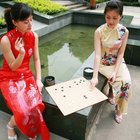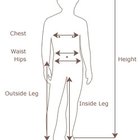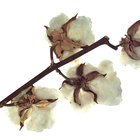
A continent as large and culturally varied as Africa produces many different kinds of fashion designs, colors and traditions. While there are traditional patterns and styles of dress, most of the unique elements of African clothing are found in the textiles that are used. From the dyeing methods to the fibers used, weaving techniques to textile prints, the color, texture -- these all contribute to African clothing. Although there are not many garments in the African tradition that are made without a sewing machine, simple wrap skirts can be created for children that do not require a needle and thread.
Cut a kanga -- a traditional cotton fabric square -- long enough to wrap around a child's waist twice.
Hold the two corners of the kanga behind the body so that one-third is on the left side and the rest is on the right.
Wrap the right side in front of the body and around the back again, leaving a fistful of the corner of the kanga on the left side sticking out from the wrap on the hip.
Bring the right side, now wrapped around the body, over to the left hip and tie a double knot with the left corner and the right corner of the kanga.
Related Articles

How to Make a Sari for Kids

How to Remove Silk Wraps

What Do Chinese Women Wear?

Can You Bind the Tummy to Tighten Loose ...

What Is Dye Made From?

How to Measure Kid's Chest Size

How to Make Sweet Brown Rice

Types of Indian Fabric

How to Sew Your Own Tubular Bandana

How to Make Kilts

How Much of the World's Clothing Is ...

How to Tie an Arabic Head Wrap

What Do the English Wear to an Amish ...

Different Kinds of Blouses

Uses of Cotton Fabric

How to Clean Viscose Shawls

How to Make a Petticoat Slip for a ...

How to Tie a Bandana Skull Cap

How to Make a Seaweed Body Wrap

How to Tie a Loincloth or Breechcloth
References
Photo Credits
Jupiterimages/Photos.com/Getty Images